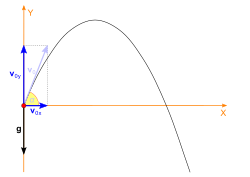Our project is based on principles of projectile motion, piezo electricity and coefficient of restitution.
Projectile Motion
Projectile motion describes the form of motion that an object experiences when it is thrown near the Earth’s surface. It moves in a curved path under the action of gravity. In our case, the projectile is the ball. After it is launched from the ramp, its path is determined by the initial velocity and the effect of gravity. Using the principles of projectile motion, we can then calculate various information about the path of the ball, for example, the height of each bounce, the coordinates of where the ball will land, the final position, etc.

Path of projectile motion (https://en.wikipedia.org/wiki/Projectile_motion)
Our ramp is designed such that it has three degrees of freedom (up and down, left and right, slide left and slide right) Most importantly, the angle of the ramp will determine the initial velocity of the ball. Users can make a prediction on the trajectory of the ball for each ramp angle that they have chosen, and use that knowledge to figure out how to ensure the ball lands on the desired key.
Piezoelectricity
Piezoelectricity is the electric charge that accumulates in solid materials in response to mechanical stress or pressure. Our box utilises piezo sensors, which are located under the keys, to detect physical contact with the ball. As pressure is applied on the sensor, it converts this pressure into electrical charge. This creates a voltage which can be detected by the Arduino microcontroller, which then creates the corresponding output.
.jpg?wmode=opaque)
How piezoelectric sensors work (https://www.azosensors.com/article.aspx?ArticleID=36)
Coefficient of Restitution
Finally, another major principle is the coefficient of restitution (COR), which is defined as the ratio of final to initial velocity between two objects after collision. A ratio of 1 would be a perfectly elastic collision. Our keys had to be made of a suitable material where the COR between the ball and the keys is close to 1, such that the height of the ball after each bounce would be sufficiently high for it to hit multiple surfaces. Our 3D printed keys, made of polyactic acid, have a sufficiently high COR with the ball, and is therefore suitable for use.
